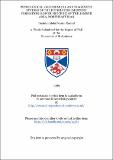Petrological, geochemical, and diagenetic studies of the Euphrates Limestone Formation (Lower Miocene) of the Jambur area, Northeast Iraq
Abstract
The Euphrates Limestone Formation in north Iraq is encountered at depth in Jambur Field and eight cores were studied in this work. The formation is overlain by Dhiban Anhydrite Formation and underlain by the basinal Serikagni Formation. The formation was deposited in a shallow lagoonal environment. Three types of dolomites have been observed in the Euphrates Limestone Formation. The first type is class A which is very fine (4-10 microns) and associated with anhydrite and gypsum. Its origin is presumed to be of contemporaneous primary dolomite formed in a supratidal environment. The second type is class B (10-30 microns in grain size) formed as a replacement of pre-existing carbonate sediments. Reflux of hypersaline brines is presumed to have been the source of magnesium for this type of dolomite. The third type of dolomite is formed of larger crystals 50-100 microns. This type is formed of euhedral and inclusion-free rhombs filling pores and vugs, and sometimes disseminated between other types of dolomite. This dolomite probably formed by mixing of meteoric water with sea water. The dolomite in the Euphrates Limestone Formation is mainly stoichiometric and well-ordered in the southern part of the studied area. Eight types of dolomitization fabrics are observed in the formation. These types range between partial to complete dolomitization with complete obliteration of the original textures. The degree of dolomitization is very extensive in the southeast part of the studied area, and decreases in the northwest direction. Dolomitization also decreases with depth. Therefore three different areas are recognized during the present work, these areas are; the southeastern (A), the central (B), and the northwestern (C). Euphrates Limestone Formation dolomite has O¹⁸O values ranging between 0.23 to 3.37 %o, which is heavier than most normal marine waters today and very close to modern sabkha dolomites. These heavy values of oxygen isotopes indicates a hypersaline environment as a source for most of the dolomite in the formation Strontium contents in the dolomite are relatively high (500-700 ppm) compared with most ancient dolomites, and similar to the concentration in Holocene dolomite. Different types of diagenetic processes which were responsible for cementation, compaction, dissolution, precipitation of anhydrite, and dolomitization are recognized in the formation. Different types of cements have been identified in the formation, namely isopachous crusts, micritic envelopes, ferroan and non-ferroan calcite. Very high moldic porosity in the oolitic fossilifeous grainstone facies are detected. The overall porosity of the formation in the dolomitized part is high and very low in undolomitized parts.
Type
Thesis, PhD Doctor of Philosophy
Collections
Items in the St Andrews Research Repository are protected by copyright, with all rights reserved, unless otherwise indicated.

